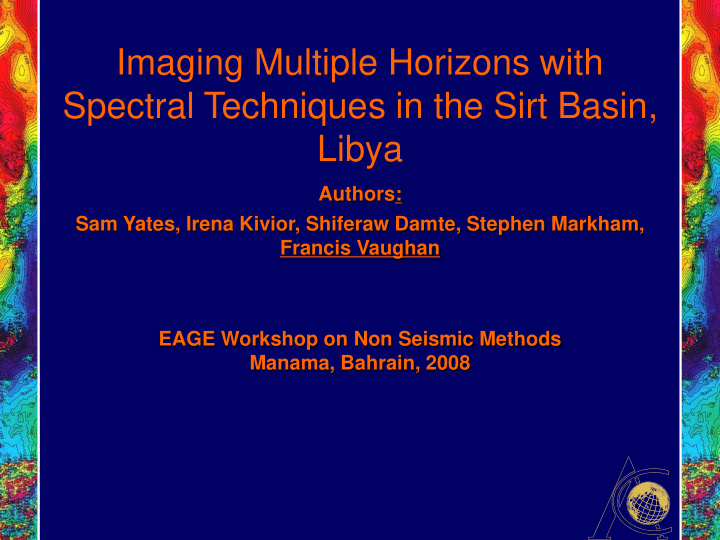



Imaging Multiple Horizons with Spectral Techniques in the Sirt Basin, Libya Authors: Sam Yates, Irena Kivior, Shiferaw Damte, Stephen Markham, Francis Vaughan EAGE Workshop on Non Seismic Methods Manama, Bahrain, 2008
Outline Sirt Basin HRAM survey Methodology Energy Spectrum Analysis Multi-window Testing Application of ESA to Sirt Basin Data Conclusions
Sirt Basin Expect a strong magnetic contrast between sediments and Precambrian basement. Also: Nubian sandstone formation Susceptibility of approximately 0.007 (SI) Hematitic siltstone: ( e.g.unit 3) 0.002 (SI) Volcanics: 0.01 (SI) Good contrasts possible between layers.
Methodology Standard transformations: RTP, vertical derivatives Data quality analysis (including 2-d spectrum) Filter maps; horizontal gradient technique for anomaly isolation Energy Spectrum Analysis Automatic Curve Matching QC through forward modelling Will focus on ESA and new Multi- Window Test.
Energy Spectrum Analysis ESA is a well established technique for estimating the depth to a (magnetic) horizon. Spector and Grant: a magnetic interface is modeled by a statistical layer of magnetized vertical blocks. E( ) e -2h (1- e -t ) 2 S( ) h = depth to top t = thickness
ESA 2 Logarithm of spectrum Curve - slope proportional to depth Perform at multiple points with data windowed to sub-region Create depth map
Window size dependency An unsuitable window size in ESA will give inaccurate results: – Window size too small: insufficient data to capture response of interface. – Window size too large: low- frequency decay dominated by deeper magnetic sources.
Synthetic tests The magnetic field generated by a Spector and Grant style random ensemble of bodies Extending from 2 km to 20 km in depth, covering approximately 75% of the 100 km by 100 km horizon. • Bodies: susceptibility of 0.012 (SI) • Additional uniform white noise added with a peak magnitude of 0.2 nT. • The generated field was sampled every 100 m.
Window too small The spectrum for a 5 km radius window gives a slope that is too shallow (1619 m), 8 km radius window gives a slope that is correct (yields 2020 m)
Window too large Multiple magnetic horizons: too large a window will give a spectrum with low frequencies dominated by the deeper sources. A risk in practice, real presence of strong, deep-seated magnetic anomalies. Another synthetic test demonstrates the issue.
Window too Large Same basement ensemble as before, – Dropped to a depth of 5 km, – Additional ensemble of objects in a layer between 4 km and 5 km. – This upper layer again has approximately 75% coverage, – Objects have a lower susceptibility 0.006 (SI). Expect to find slopes that correspond to the two horizons at 4 km and 5 km, Also slopes that underestimate the top horizon, or pick some intermediate depth between the two.
Too Large 2 Window radius 6 km slope 1446 m Window radius 12 km slope 3973 m Window radius 20 km slope 4503 m Window radius 26 km slope 4994 m
Multi Window Test How to determine a suitable window size? The idea: – Calculate decay rates for lots of windows sizes. – Heuristic: solutions with low dependence on window size are likely to be meaningful.
The MWT procedure MWT over a point: spectra calculated 1. in small increments in window-size (typically two grid-cells or so.) Spectra interpreted to produce a 2. depth estimate. Depth estimates plotted 3. regions of stability identified Stable depths: 4. Likely depths to magnetic interfaces Window sizes in the stable region good candidates for applying ESA.
MWT Plateaus
Synthetic test
MWT along a profile Performed MWT at each point along a profile, Stability of a depth solution at each point plotted to produce an image. Stability at a given depth is represented by window density – measure of how many window sizes give that depth. Horizons intersecting the profile then are imaged as lines of high-stability in the 2-d plot.
Automatic Interpretation Producing a consistent set of interpretations for each of these window sizes is a time consuming process. Even when partially automated by software. In areas with good data quality – totally automatic interpretation becomes feasible – can rapidly produce MWT profiles for preliminary depth estimation and optimal window-size determination.
Application of MWT in interpretation process Automatic MWT profile-plots along profiles of interest – gives rapid indication of structures and preliminary depth estimates. A detailed, supervised, MWT: – performed at coarse selection of points in the area of study. Window-sizes corresponding to sound plateaus are identified, – used as basis for Energy Spectral Analysis moving window around those points.
Recommend
More recommend